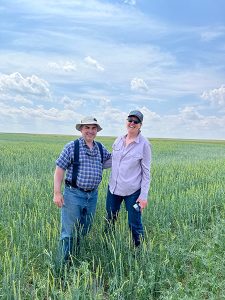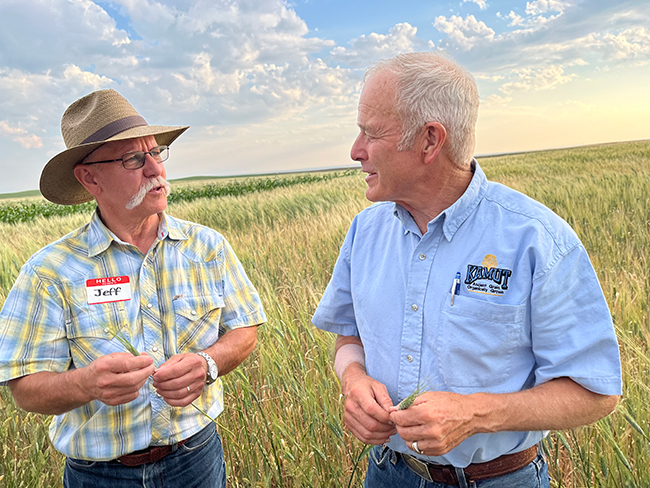By Kathleen Delate, Professor-Organic Ag, Iowa State University
Wheat Love
Deep in the caverns of the sassi of Matera, Italy in 2014 was the beginning of our love of all things Triticum. We were introduced to durum wheat, Triticum turgidum subsp. durum, a tetraploid wheat (28 chromosomes), whose grain/flour/pasta has a lower glycemic index than regular wheat, which translates to a delayed release of glucose upon consumption, versus the more glutenous hexaploid wheat (42 chromosomes) we grow in Iowa.
Fast-forward nine years to the organic wheat variety trial we grew at the ISU Neely-Kinyon Farm in Greenfield, Iowa. Varieties with names like ‘Expedition’ and ‘Shelly’ grew next to the ‘Climate Blend’ winter wheat developed by Steve Jones, wheat breeder at Washington State University’s Bread Lab as a mix with characteristics that are “resilient in climate change.” The drought in June 2023 that left us 5 inches below normal rainfall was a good test of that!
The Montana State of Mind

Doug Crabtree and Anna Jones-Crabtree in their organic barley and pea field, Havre, Montana.
Before harvest, we headed for Montana to take in the Organic Wheat Capital of the U.S. We were guests of Bob Quinn in Big Sandy, Montana, population 596, with the entrance sign to the town boasting “Home of U.S. Senator Jon Tester.” We tour his beautiful fields of kamut, native corn, and squash, reveling in “Big Sky Country.”
At Ma’s Cafe in Loma, Montana, the taxidermic fish on the wall, shovelnose sturgeon, walleye, pike, catfish and smallmouth bass, were some of the trophies the owner, Charlie, had landed from the near-by Marias River, named after Merriwether Lewis’ (of Lewis and Clark fame) cousin named Maria, after stopping here in 1805.
With no time for fishing, eight ag researchers, medical professionals, and environmental media folks hashed out details for a new research institute, focusing on organic ag for the western U.S. Plains region: the Quinn Institute.
We also visited Anna Jones-Crabtree and Doug Crabtree, the organic farmer dynamic duo, in Havre, Montana, near the “Hi-Line,” as the region around Highway 2 in northern Montana is called. Stretching from North Dakota to Idaho, the area boasts weathered farmsteads, stately grain elevators, and unusual field colors of lemony canola abutting the golden barley and purple-blue flax. The area also hosted the Great Northern Railway which brought sizeable wealth to the town and is the same tracks used by Amtrak to deliver Anna and Doug to the LaCrosse, Wisconsin, station for their keynote at the MOSES conference in 2023. Trains also take Doug and Anna’s grains to La Milanaise an organic milling family in Quebec, who prides themselves on high-quality, identity-preserved, organic end products.
On Vilicus Farms: https://vilicusfarms.com we talk about building capital from organic grains turned into delicious organic cereal, bread, and beer. And getting more people into organic farming! Anna, an engineer by training, with a Ph.D. in Civil Engineering and a specialization in Sustainable Systems, never stops thinking of ways to tweak the farm and bring more people into the farming world. Her quote: “The only way we are going to thrive on this planet is to work on our relationship with nature.”
Bee-laden sunflowers surround the two tiny houses they’ve built to house interns and visitors and connect with their extensive work with the Xerces Society. Doug, the master tinkerer with a family farm background and years in organic production and certification, talked climate change and how the winter wheat was 2-4 weeks late, due to extremely dry weather in 2022. Even though they were getting unusual, abundant rains in 2023, the impact of planting the wheat last Fall into dry soil will decrease yields.
Their Community Supported Stewardship Agriculture (CSSA) project includes more than food: it allows anyone to backstop their work through a donation system based on supporting their stewardship operations on one acre for $100 per year. In return, subscribers can follow their adventure through regular communications.
Anna and Doug’s idyllic fields of intercropped organic barley and yellow pea bear witness to the words on their webpage: “Vilicus Farms grows a diverse array of organic heirloom and specialty crops with a cropping practice focus on soil-building and carbon sequestration, pollinator friendly conservation tactics, and minimum disturbance tillage practices.” They show us detailed, color-coded records of the fields of their 20 unique crops planted annually in their 5- to 7-year crop rotations, and the 26% of their land planted in permanent pollinator-friendly habitat, striving to promote diversity and resilience across the landscape.
Another great organic Montanan, Margaret Scoles, head of the International Organic Inspectors Association, grew up on a small ranch near Broadus, MT. She grew up in the 1960-70s doing her homework by kerosene lamp or a light connected to a generator, since her father had an argument with the electric cooperative, and also refused electricity for the house. This independent spirit arose from her grandparents on both sides, who were among the 1919 homesteaders. The slogan of “Food will Win the War!” egged Montana’s homesteaders to plow and plant, even in the face of the upcoming drought and bank failures of the 1920s and 1930s.
According to UM historian Derek Strahn: “If Montana’s history has been shaped by one telltale pattern, it is the cycle of boom-bust development so clearly embodied in our homesteading and mining experiences. It is this factor—more than any other—that has shaped our character and cultivated our resiliency. Without hope and hardship, we simply would not be.”
Like so many native sons and daughters, Margaret moved back to Montana in 1981 after graduating with an agriculture degree from the University of Arizona. Blending her love of science with a love of farming, she and her husband, Bob, have been ranching since then, amidst Margaret’s shepherding of hundreds of organic inspectors in the U.S. and across the globe. “Any person on Earth who has taken an IOIA training has been affected by Margaret’s indefatigable efforts to improve the integrity of organic farming, production, distribution and sales,” wrote a nominator for her Organic Trade Association award in 2018.
So next time you bake bread with delicious organic kamut flour from Breadtopia in Fairfield, Iowa, remember the mighty Montanans who may have grown or certified the crop for you. We anxiously await news from the Quinn Institute in their search for solutions to “address global challenges like climate change, drought, desertification, ag chemical pollution and chronic disease.” And after a wonderful visit to Organic Montana, I am convinced that, if anyone can tackle five challenges at once, it would be a Montanan!





